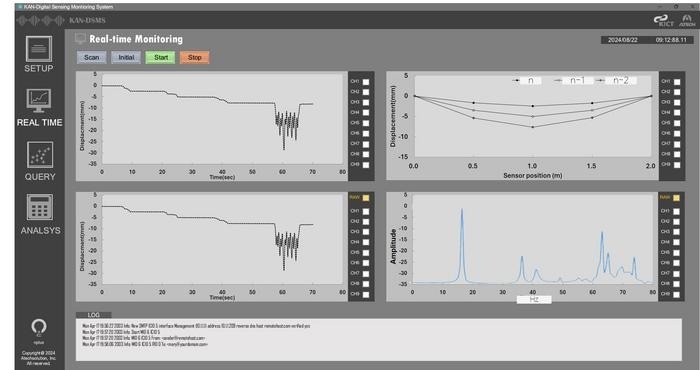Reviewed by Lexie CornerNov 25 2024
The Korea Institute of Civil Engineering and Building Technology (KICT), led by President Kim Byung-Suk, has developed an advanced monitoring system that uses digital sensing technology to aid in the maintenance and management of small- and medium-sized aging bridges.
 The program was developed only for this project. It acquires data from the digital sensors and analyzes structural deformation and vibration in real time. Image Credit: Korea Institute of Civil Engineering and Building Technology.
The program was developed only for this project. It acquires data from the digital sensors and analyzes structural deformation and vibration in real time. Image Credit: Korea Institute of Civil Engineering and Building Technology.
This initiative was part of an international collaborative research project funded by KICT in partnership with the University of Transport and Communications (UTC) in Vietnam. The project aimed to lay the groundwork for technology transfer to ASEAN countries.
Bridge maintenance monitoring technologies are typically designed for long-span structures, such as cable-stayed and suspension bridges. These systems require substantial resources for design and installation, and their complex configurations limit their suitability for managing small- and medium-sized bridges.
Current bridge monitoring systems predominantly rely on analog measurement and sensing methods. However, the analog approach is prone to electrical noise, significantly impacting data quality.
Additionally, it struggles to efficiently process the diverse signals collected by sensors. Another limitation of analog sensors is the need for 1:1 wiring between each sensor and receiver, which increases system complexity and drives up installation costs as the system size grows.
To address these issues, KICT has implemented a digital sensing technique. This method minimizes the risk of noise-induced data quality degradation while offering superior data transmission speed and processing capabilities, effectively overcoming the limitations of analog sensing systems.
The BUS communication serial connection method allows multiple sensor data to be integrated and transmitted through a single wire. This approach is widely recognized for its simplicity and cost-effectiveness and is extensively applied across various fields. It also simplifies system configuration, making it a practical alternative to analog sensing.
The rapid economic growth in Vietnam has driven the construction of various transportation infrastructures, including bridges. However, the demand for effective maintenance techniques has become increasingly pressing.
While foreign expertise and technologies have been employed for facility maintenance, their application has been largely restricted to long-span bridges and large structures due to budget constraints, technological limitations, and a shortage of skilled professionals.
Safety monitoring systems for routine maintenance of small- and medium-sized bridges remain absent, highlighting the need to implement efficient monitoring methods tailored to the region's specific requirements.
The research team, led by Dr. Dong-woo Seo from the Department of Structural Engineering Research at KICT, developed a monitoring system specifically designed for efficient application to small- and medium-sized aging bridges using digital sensing techniques. The system's performance was validated through on-site demonstrations conducted in collaboration with the research team at UTC in Vietnam, confirming both its measurement accuracy and local applicability.
The smart monitoring technique created by KICT can precisely calculate the vertical displacement of a target bridge using simple sensor placement and coordinate inputs. The results are presented to users in real-time via a graphical user interface (GUI), requiring minimal operations to manage the system and generate outputs.
During local verification in Vietnam, the system demonstrated an accuracy of over 95% when comparing measured vertical displacements with actual deflection results. Additionally, the developed system and monitoring algorithm technology have been transferred to ATECH SOLUTION, Inc. for commercialization.
The biggest advantage of the developed digital smart monitoring technique is user-friendliness. Easy to use and economical monitoring technique through a simple system installment method using digital sensors and a GUI-based data analysis system.
Dr. Dong-woo Seo, Department of Structural Engineering Research, Korea Institute of Civil Engineering and Building Technology